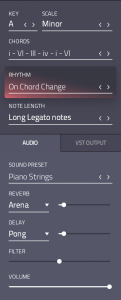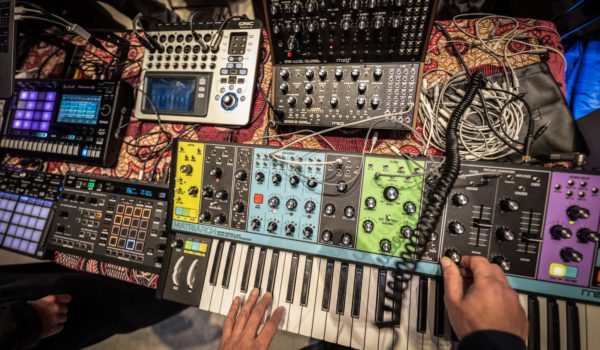CAPTAIN Plugins are a kit of 4 separate, yet interlinked, plug-ins respectively named CAPTAIN Chords, Deep, Melody and Play.
These plug-ins are the latest brainchild of Mixed in Key, a music software manufacturer that has made a name for itself by developing a very efficient harmonic mixing software of the same name. It has been adopted by DJs worldwide, including some very notable names, thus quickly making Mixed In Key a staple in a DJ’s toolkit as well as an industry standard.
For over a decade, Mixed In Key have developed some very powerful, useful, intuitive, creative and most importantly fun-to-use software tools for DJs and producers. Which brings us to CAPTAIN Plugins.
CAPTAIN Plugins are a new set of tools specially designed to help composers and producers explore new ideas and deepen their musical knowledge. From what I’ve seen so far, it seems promising.
Here’s a brief overview of the features, with a more detailed breakdown further down in this article.
Given the manufacturer’s pedigree, I was very excited at the opportunity to experiment with these plugins. I was also very keen to see if these tools would help me save time and, more importantly, do so without sacrificing creativity and feeling.
The plug-in’s names are straightforward as to their functionality:
- CAPTAIN Chords: Allows you to write chord progressions with ease, experiment with variations and discover new possibilities.
- CAPTAIN Deep: Does the same for rhythmic basslines.
- CAPTAIN Melody: …for creating melodies and hooks.
- CAPTAIN Play: … is for.. well.. jamming.
… and all is done conforming to the given key and scale !
According to Mixed In Key’s website, these plugins are “Designed for Ableton Live and Apple Logic for Mac” but are offered in VST and AU format which means that there is no reason for them not to work in other DAWs. Live and Logic aside, I’ve also used them successfully in Harrison’s Mixbus32C (v4) and Cocos Reaper (v5.78). Unfortunately, CAPTAIN Plugins only support 64-bit host DAW applications and will not work with 32-bit DAWs. Current support is for Mac OS X, and only CAPTAIN Play is offered for Windows at this time.
Each plug-in goes on it’s own respective MIDI track in your DAW and once you open it’s interface, you’ll be prompted to specify they key and scale you’d want to compose in. Hit Play and you’ll start hearing that particular plug-ins’s default sound playing its default pattern: A pad-type sound for Chords, a bass sound for Deep and a lead-type sound for Melody.
All of the plug-ins have a similar user interface so we will focus on CAPTAIN Chords as an example:
The plug-in’s interface can be broken down into sections: the most recognizable is the piano roll-style note display where you can view and edit the progression.


The column on the left of the interface allows to change the key and scale of the song, choose a chord progression, set a rhythm as well as note length. While the plug-in comes with a nice selection of scales as well as a generous library of progressions and rhythmic presets, I am certain that some advanced musicians would welcome the ability to create custom scales. CAPTAIN Plugins have their own sound engine with a palette of 200-some decent sounding sounds divided into various categories such as Plucks, Keys, Strings, Lead and Guitar. An unexpected, yet pleasant surprise. In the lower section of the column, you’ll also find the sound engine’s limited, yet useful, set of parameters; namely Sound Preset, Reverb, Delay and LP/HP Filter. In the VST incarnation of the plug-in, there is a tab marked ‘VST Out’; this allows us to route all MIDI data to any software synth loaded in your DAW, bypassing the CAPTAIN Chord’s internal sound engine. The AU version of the plugin has this tab labeled ‘MIDI Out’, but it seems not to be functioning in this version of CAPTAIN Chords.
 The horizontal section on top of the piano roll allows for the editing of chords. You can edit the chord length, split, delete & change chords and place rests or gaps between them. In doing so, you create your own chord progressions that can be saved for later use. There is also a set of slightly more advanced parameters labeled ‘Inversion’, ‘Octave’, ‘Flavor’ and ‘Complexity’. These are there to allow you to custom tailor your chords to the desired feel, smooth things out within a progression or to simply beef up the sound. All while remaining in key.
The horizontal section on top of the piano roll allows for the editing of chords. You can edit the chord length, split, delete & change chords and place rests or gaps between them. In doing so, you create your own chord progressions that can be saved for later use. There is also a set of slightly more advanced parameters labeled ‘Inversion’, ‘Octave’, ‘Flavor’ and ‘Complexity’. These are there to allow you to custom tailor your chords to the desired feel, smooth things out within a progression or to simply beef up the sound. All while remaining in key.
Once satisfied with the progression, simply drag-n-drop the MIDI clip into your DAW, edit it if need be, and use it to play your instrument of choice.
Here’s a clip that demonstrates this in greater detail.
Another very useful feature are the grouping tabs. They can be seen at the top of the interface, labeled ‘VERSE’, ‘PRE-CHORUS’, ‘CHORUS’ and ‘DROP’. These can be incredibly helpful in the arrangement of your song. Each tab has its own piano roll timeline, with it’s own chords for each section of the song. This way, the entire song structure can be created within one instance of the plug-in and each part can be placed one by one into your DAW project. I found it to be quite intuitive and one of several time savers this plug-in has to offer. There are also ‘MIDI In’ and ‘PLAY’ tabs; the former allows the plug-in’s sound engine to be used as a regular softsynth and the latter allows for chord progressions to be created in real-time, by jamming on the computer keyboard while maintaining the correct key and scale. Probably the quickest way to generate progressions.
I can say that I truly enjoyed test-driving this software: Installation was smooth and quick, so was the authorization. The entire experience was absolutely problem free and no apparent bugs or hurdles have manifested themselves.
The interface is clearly laid out and I found the learning curve to be very mild. Having watched the YouTube tutorial (above) and glanced over the How-To Guide, I had a really nice progression going within minutes and immediately felt compelled to start building a new track around it. Very inspiring. I can only imagine what can be done once some time has been put into it. My only observation is that some novices with little or no knowledge of music theory may initially get intimidated by some of the terminology, but they should not be.
This is a well engineered piece of software that yields quick results. It is fun, very creative and does the job well. Bravo !
Pros: Incredibly creative and intuitive software. A fantastic chord, bass, hook and melody tool. Intelligent interface with grouping tabs that really simplify arrangements. You get a lot for your money. This software will benefit musicians and producers of any caliber and expertise.
Cons: Inability to create custom scales (although I can see this being addressable in a future update). Could be mildly intimidating to users having zero music theory training (but at the same time, this can be a great learning tool as well). No legacy support for 32-bit DAWs.
Price: $79 USD for all four plug-ins. Early customers will get a fee upgrade to CAPTAIN Hook and Captain Beat.
Article by Yul Pug.









Comments